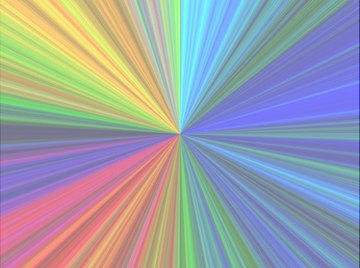
A spectrophotometer is used to determine the concentration of certain compounds, such as protein, in a solution. In general, a light shines through a cuvette filled with a sample. The amount of light that is absorbed by the sample is measured. Since compounds absorb light in different spectral ranges, the right wavelength must be set for the analysis. There are numerous ways to calculate the concentration of unknown samples through spectrophotometry, however using reference standards gives the best accuracy. Furthermore, standards also indicate if the spectrophotometer is malfunctioning or other problems with the analysis.
Calculating through Straight Line Equations
Analyze reference standards at the beginning of the analysis. Standards are known concentrations and are used to calibrate equipment and check accuracy. All samples should fall within the working range of the standards. If not, then samples will need to be diluted or the concentration of standards increased.
Make a scatter chart or line graph with standard concentration and absorbency readings. The concentration will be on the y-axis, the absorbency on the x-axis. For example, the standards are 1 ppm, 2.5 ppm, and 5 ppm. The absorbency given was 1 ppm= .25, 2.5 ppm= .5, and 5 ppm= .75.
Format the trend line to display an equation on the graph. The equation will show the formula y=mx+b. For example, using the standards in step 2 the equation is y= .1224x + 0.1531. Most trend lines are intercepted at zero, but it depends on the analytical method and R-squared value.
Analyze unknown samples and record absorbency readings.
Use the equation (y=mx+b) to determine concentration of samples.
Understanding Straight Line Equation
- Spectrophotometer
- Reference standards
- Unknown samples
- Excel, spreadsheet, or graphical software
The units of the concentration will be the same as the standards. For example, units are parts per million (ppm) or parts per billion (ppb).
Reference standards and samples are easily contaminated.
Always read all parts of assay or method before developing.
Let “Y” equal the concentration. This is what will be solved for.
Let "X" equal the absorbency of the sample. This is the absorbency measured by the spectrophotometer.
Allow “” to equal the slope and “b” to equal the y-intercept. Both are given, however if the trend line was forced through 0, then “b” will be 0.
Solve for concentration. Using the example in step 3, substitute "x" as a given absorbency of .563. Therefore:
y= .1224(.563) + 0.1531
y (concentration)= .222011
Things You'll Need
Tips
Warnings
References
Tips
- The units of the concentration will be the same as the standards. For example, units are parts per million (ppm) or parts per billion (ppb).
- Reference standards and samples are easily contaminated.
Warnings
- Always read all parts of assay or method before developing.
About the Author
Specializing in home and garden topics, Nina Stanley begin her freelance career in 2009. She received her Bachelor of Science in horticulture in 2007 from Sam Houston State University and Associate of Science in 2002 from Blinn College. Through her writings, she shares her knowledge of plants with others on various websites.
Photo Credits
spectre angulaire image by Unclesam from Fotolia.com
